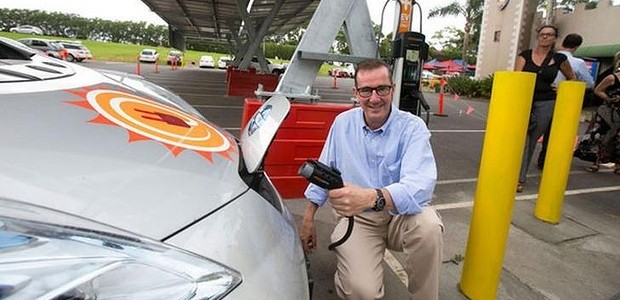Read the article
For 40 years, the Macadamia Castle between Ballina and Byron Bay has been a refuge for weary travellers – a timely pullover stop for family station wagons loaded to the hilt with luggage and for sun-tanned backpackers alike.
But the Knockrow fortress could soon become a hot spot for a completely different reason. In the corner car park resides a 180-panel solar grid sitting atop a newly constructed car port, generating enough electricity for the castle and its surrounding grounds. According to the castle’s owner, the abstract structure represents the beginning of an electric revolution.
“At one end of the car port are two charging stations for electric cars, almost like petrol bowsers,” Tony Gilding explains. “They’ve been installed to make people feel more confident about driving longer distances in electric cars. We’re probably five or 10 years ahead of the game, but I see this as the way of the future.”

And he is not alone.
Despite new car sales figures which reflect little demand for electric cars, Australia is on the verge of a big infrastructure investment in the technology from this year.
American electric car company Tesla has announced plans to launch 16 high-powered supercharger stations between Melbourne and Brisbane by 2016, 10 of which are flagged for completion this year. Theoretically the stations will allow a Tesla customer to travel between Brisbane and Melbourne without paying a cent for electricity – simply plug into a supercharger and wait 20-odd minutes (giving you a circa 250km range – depending on the model – a full charge takes one hour).
The same formula appears to be gaining momentum in the US, where Tesla has been present since 2012 and now offers a supercharger network exceeding 140 stations.
In addition, established luxury brands such as BMW are increasingly testing the waters of the local electric market.
Electric investment has yielded mixed responses in the past. A similar, though smaller rollout of free electric charging stations was trialled in Australian capital cities with minimal take-up and only 1015 electric cars were sold nationally last year, during a time in which the total new car market exceeded 1.1 million vehicles.
However, Tesla is adopting a “build it and they will come” mentality to electric cars in Australia and feels it will soon have the right formula and model mix to help the technology gain traction.
“It is real and it’s here,” Tesla spokesman Heath Walker said.
“We’re taking a two-pronged attack in Australia: our supercharger network and also new hotel partnerships where we’re putting high powered wall units in different hotels – both single and three phase.” The Darling Hotel in Sydney and the Marriot in Melbourne are already up and running.
Walker cited range anxiety and high purchase prices as the biggest barriers to electric cars until now, in addition to infrastructure.
“Charging at home has been another perceived barrier, but now we provide a unit that provides 40 amps of power and hooks up to the house. You can charge overnight and have up to 500km of range the next morning,” he said.
Launched last year, the cheapest Tesla available in Australia costs $91,400 (plus on-road costs) and is capable of travelling up to 390km on a full charge, which costs the household electricity payer about $25.
At the lower end of the market, a Nissan Leaf costs $39,990 (plus on-road costs) and has a range of up to 170km – something previously at odds with Australia’s sparse layout.
But Mr Gilding, who lists Tesla founder Elon Musk as “a hero”, believes creating more incentives to own an electric car, such as free charging, would spur along demand.
“I’ve been following Tesla since the beginning, the forward thinking that Musk has shown in the design of those cars, the range, is pretty cool,” said Gilding, whose car charging station required an outlay of $140,000 and is currently free for public use.
“If we could get something like that happening in Australia, the way we think about cars promises to change as we know it.”

